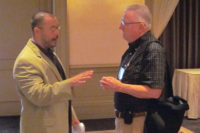
Global Warming Potential
The world may have won the battle against ozone depletion, but that was just a "tempest in a teapot" when it comes to the issue of global warming. That was the perspective of David Fahey, research scientist at the Aeronomy Laboratory of the National Oceanic Atmospheric Administration.Fahey did not assign specific blame for the global warming problem. Rather, he said it involves such factors as "population, economy, environment, technology, and globalization." Many in the audience were aware that HFC refrigerants have been targeted as part of the global warming issue and have come in for calls for phaseout in some parts of Europe.
Fahey said more research is needed to get a definitive handle on the topic. "That could provide us some options we don't even envision today."
He said the ozone depletion concern has been resolved thanks to adherence to the Montreal Protocol. He said there needs to be continuous investment in ozone control. "We have to maintain diligence and not reverse our position."
But, he said, "Climate change is a totally different issue. An increasing body of observation gives a collective picture. Emissions of greenhouse gases and aerosols continue to alter the atmosphere."
One issue is population growth. "Human influence will continue to change the atmospheric composition throughout the 21st century," he said. "When we emit CO2, it is like emitting it into a box."
He asked, "What do we have to do to stabilize CO2 emissions?"
Some of the global warming issues relate to rising temperatures and sea levels. He said it is important to expand climate observations and to improve model simulations.
He did not address the European calls for a phaseout of HFCs, but did say that "any climate response will likely take many centuries" to see resolution.

Security
James Hill, acting director of the Building and Fire Research Lab at the National Institute of Standards and Technology, reviewed risk assessment in today's building planning. Those who work on HVACR systems in large buildings have always factored in safety. In recent years, he said, security has become just as significant.Terrorism that may involve chemical or biological agents, or other acts producing mass destruction, have been added to natural threats such as fire, wind, and rain, or criminal threats such as burglary and arson.
In light of the events of Sept. 11, 2001, Hill noted, "Terrorism involving the building environment came to America spectacularly, if not frequently or widely."
He noted that the World Trade Center attacks of 1993 and 2001 have been the only ones against commercial buildings in the United States; in fact, the focus of terrorist attacks has been on public buildings, including U.S. embassies and military bases.
"Worldwide, the number of attacks on commercial buildings over the past 30 years is very small," said Hill, citing a report from an August 2003 workshop in which hundreds of persons involved in building security met.
That seminar produced a three-point criterion for looking at how far efforts can go in securing a building.
"Protecting every building against every possible threat is not feasible. Protecting every building against some possible threats is not feasible. Protecting some buildings against every possible threat is not feasible. Protecting some buildings against some threats is feasible.
"The private sector needs to understand what buildings are at risk, what those risks are, what options are available to offset those risks, be able to choose the options that are best, and have standards for implementing those options," he said.
"Most buildings don't need anything done to them because they are not at risk."
He said a number of government agencies have been producing publications addressing these issues in commercial construction; reviews are underway concerning changes in codes and standards. Hill pointed out that any "national model codes represent minimum requirements for building construction."
Publication date: 08/23/2004





